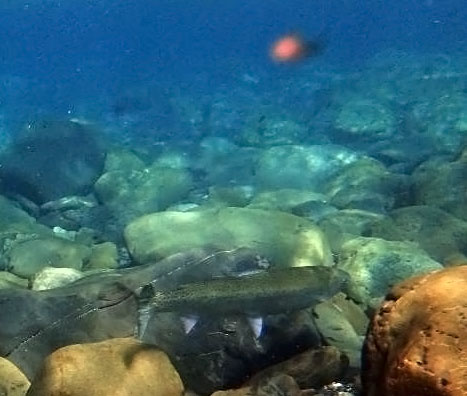|
You are viewing ARCHIVED content published online before January 20, 2025.
Please note that this content is NOT UPDATED, and links may not work. For current information,
visit https://www.nps.gov/aboutus/news/index.htm.

NPS
Contact: Barb Maynes, 360-565-3005 Fisheries biologists monitoring restoration of the Elwha River and ecosystem recently confirmed that adult Chinook salmon, sockeye salmon, steelhead and bull trout have all passed upstream through both the former Elwha and Glines Canyon dam sites to reach the upper Elwha River. "We are thrilled to see this latest confirmation of the success and value of dam removal," said Acting Superintendent Rachel Spector. "As restoration proceeds, the benefits continue to mount along the entire river and throughout its entire ecosystem." An early August snorkel survey between Rica and Glines Canyons revealed five adult Chinook salmon, one steelhead and ten adult sockeye salmon. Biologists were even able to watch as two sockeye pairs dug their nests or 'redds' near the Boulder Creek confluence within the former Lake Mills. Later in August, another snorkel survey was conducted between the Hayes River confluence and the Elkhorn Ranger Station along the Elwha River. During this survey, biologists found Chinook, summer steelhead and bull trout, all located upstream of Glines Canyon. Biologists also use radiotelemetry to track and monitor fish throughout the Elwha. Fish are tagged in the lower river with a small radiotransmitter. As fish move through the river, their radio signals are detected by fixed antennae placed along the river banks and by biologists walking or flying above the watershed. Through this process, biologists were able to track an18-inch bull trout from where it was tagged near the river mouth to a site 29 miles upstream near the confluence of the Goldie River. The signal also showed that the fish traveled the 16 milesfrom Glines Canyon to the Goldie confluence in two weeks. "These observations indicate that last year's rockfall demolition was effective in improving fish passage through Glines Canyon," noted Spector. Last fall, contractors demolished 14 large boulders thatwere part of a rockfall that occurred sometime between dam construction in the1920s and the beginning of dam removal in 2011. Following dam removal, sediment and debris moved downstream and accumulated above the rockfall, creating a barrier to upstream fish passage. Scientists use a variety of tools to assess Pacific salmon and trout migrations through the former dam sites and canyons including radiotelemetry, snorkel surveys, redd surveys and environmental DNA. Later this month, biologists will use redd surveys and environmental DNA to assess Chinook salmon recolonization and spawning throughout 40 miles of the river. Monitoring ecosystem recovery in the Elwha is a cooperative effort by Olympic National Park, Lower Elwha Klallam Tribe, U.S. Fish and Wildlife Service, U.S. Geological Survey, NOAA Fisheries, Washington Department of Fish and Wildlife and the Coastal Watershed Institute. In addition to the fish found in the upper river this summer, biologists have observed adult pink, coho and chum salmon, and Pacific lamprey upstream of the former Elwha Dam site. More information about the world's largest dam removal and the ongoing restoration of the Elwha River and ecosystem is available at https://go.nps.gov/elwha |
Last updated: October 17, 2016
